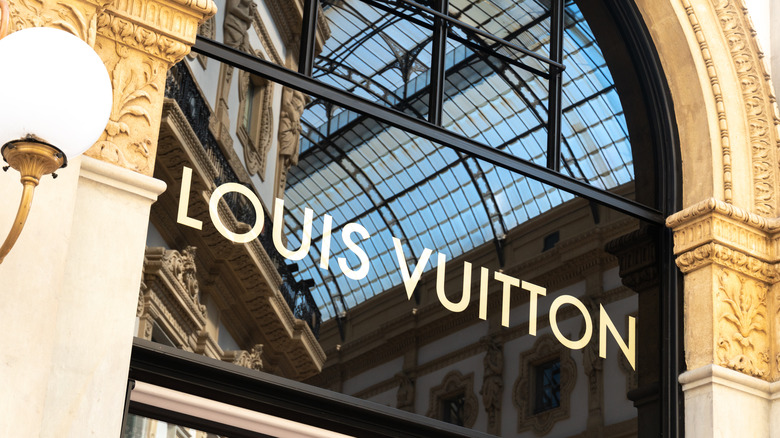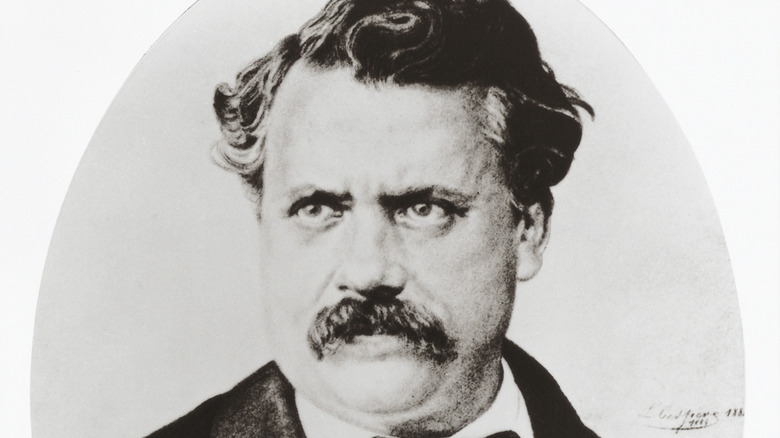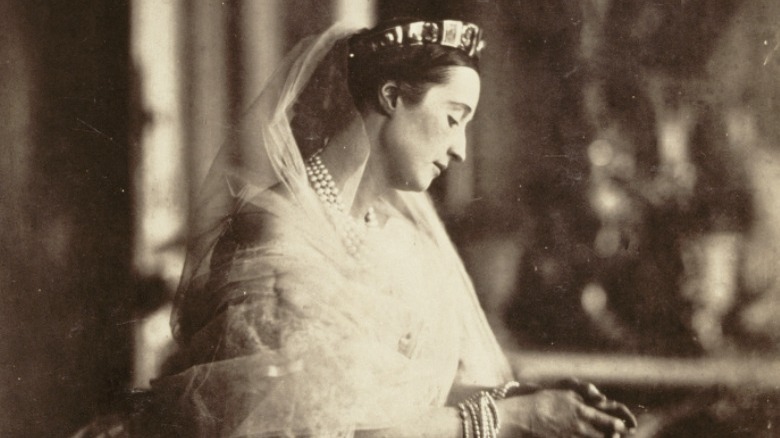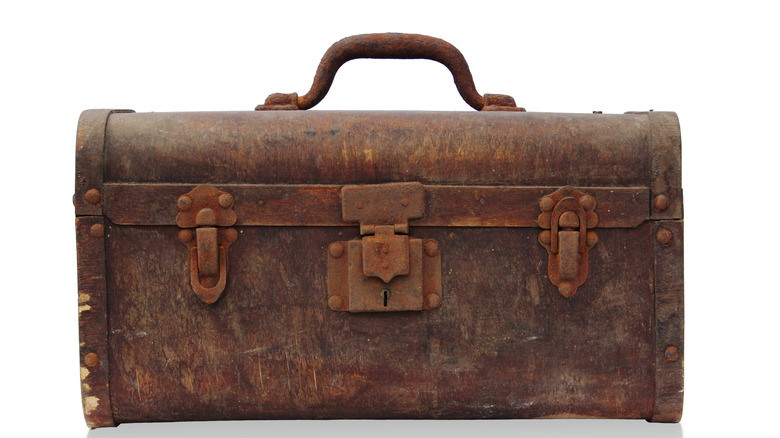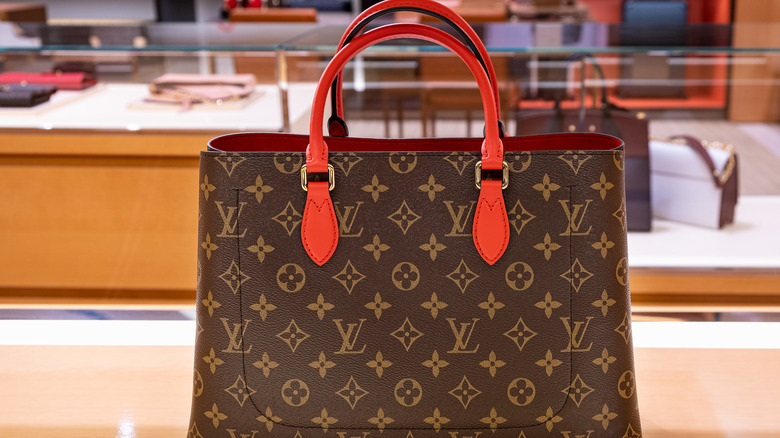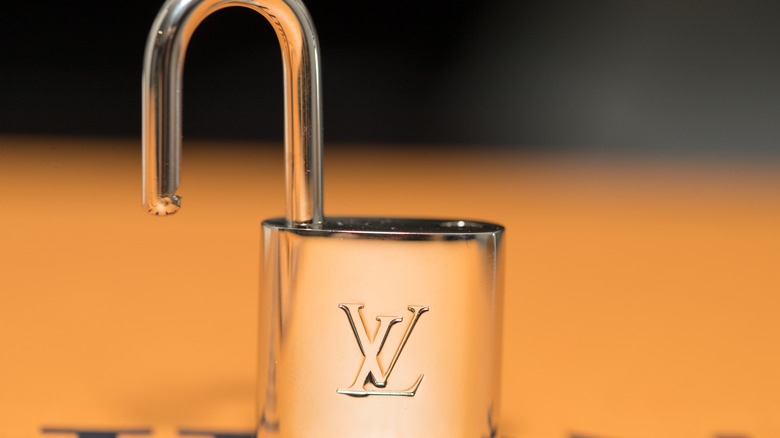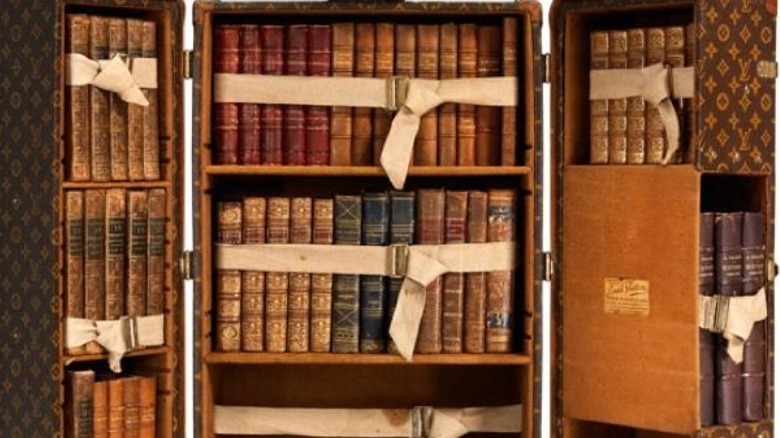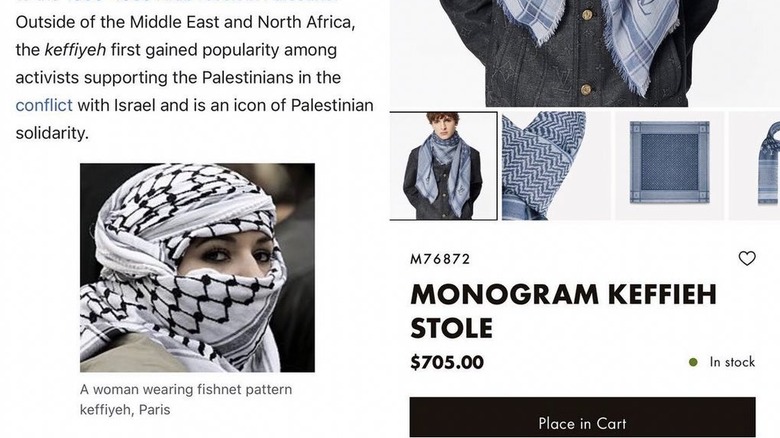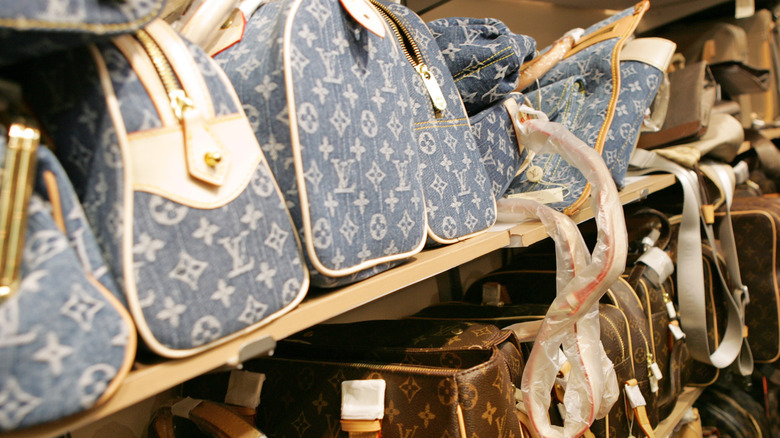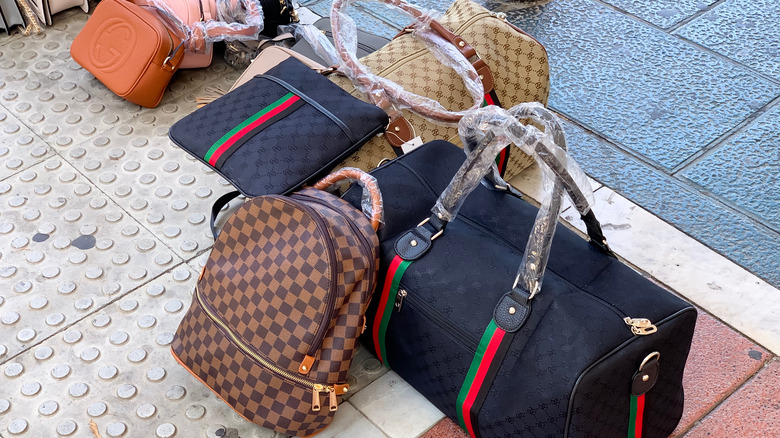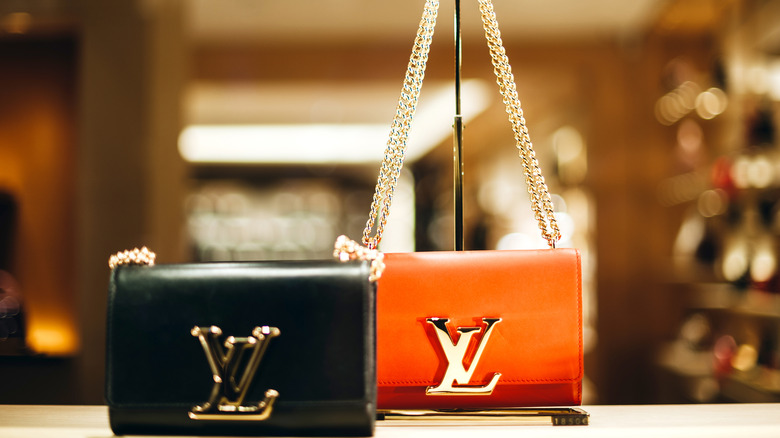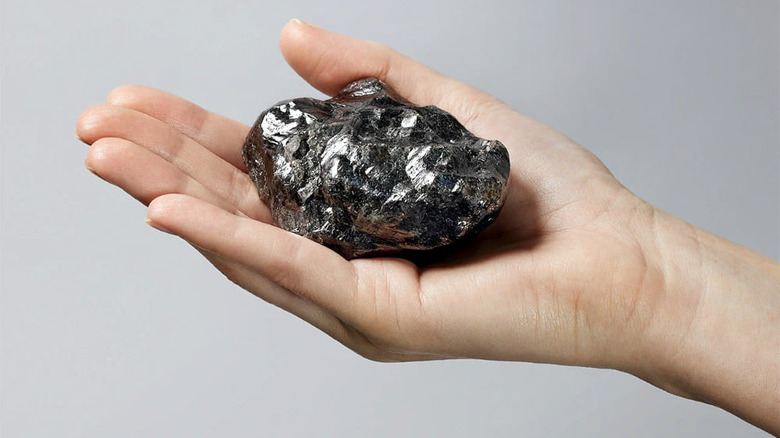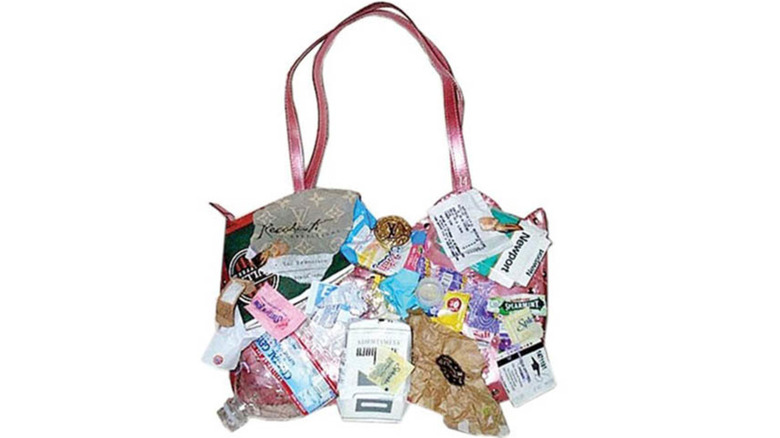The Untold Truth Of Louis Vuitton
Louis Vuitton, the French luggage and handbag maker that is a byword for luxury, has been in business for more than a century, after its founding in 1854 by its namesake. You don't survive that many years without courting controversy along the way –- but the fact that the Louis Vuitton corporation collaborated with the Nazis in World War II places them in rarefied company on the list of firms that supported them.
Still, the company that epitomizes the good life in its line of luggage, handbags, clothing — and now, jewelry — not only survived a 2004 public relations nightmare but has now gone on to become the most valuable luxury brand in the entire world (via Forbes). Founded by a young man of humble origins, the company has historically been the brand of the rich and famous, including the empress of France, the Rockefellers, Hearsts, and Vanderbilts, notes Harpers Bazaar.
Vuitton's genius revolutionized travel in the 1800s, and the style he gave to his creations has stood the test of time. His monogram carries a cachet like no other in the world of fashion, and the company's offerings are the epitome of elegance even today. In 2021, LV reported a staggering $75.973 billion in earnings, a 48.95% increase over the year prior, according to Macrotrends.
Founder was born to working-class parents
More than a century before the company was featured in global headlines, its founder started out life in modest circumstances. Despite his eponymous firm going on to epitomize ultraluxury, his family had humble origins.
As Biography tells the story, Louis Vuitton was born on August 4, 1821. His father was a farmer, and his mother was a milliner, or hatmaker. Sadly the family matriarch died early in his life. Vuitton's stepmother was reportedly so evil that he ran away from his home in the Jura mountains when he was 13 and headed for Paris –- on foot. It was a journey of 292 miles.
To survive, he performed odd jobs along the way, finding whatever shelter he could. By the time he turned 16, he had made it to the glittering capital city of France. After going to work as an apprentice for boxmaker Monsieur Marechal, Vuitton quickly learned the skills that would enable him to create his iconic trunks and handbags.
In those times, boxmakers were in high demand; their products were essential in the days of long journeys by steamer and horse-drawn coach. Skilled boxmakers and packers were entrusted with protecting the extremely expensive handmade gowns and other clothing worn by the upper classes, expertly making boxes to fit the items and adeptly packing them to ensure their care. Vuitton had already found his niche, catering to high society at a time when the Industrial Revolution was making people fortunes -– while there was still of course an enormous amount of poverty in Paris.
Louis Vuitton was appointed boxmaker to wife of Napoleon III
Just a few years after arriving in Paris, Louis Vuitton had become such an accomplished maker of boxes and trunks that he was appointed official boxmaker to Empress Eugenie, the consort of Napoleon III, according to Biography. At a time when boxmakers not only custom-made but packed their boxes as well, with the ornate gowns of the day, these specialists were in high demand by the nobility and royalty. After being appointed as the empress' boxmaker, Vuitton was charged with "packing the most beautiful clothes in an exquisite way,"
As Royal Central details, Empress Eugenie was one of the great tastemakers of the day, setting the fashion for the extraordinarily fashion-conscious French society of the time, when the monarchy was attempting to re-establish its legitimacy after her husband, the third son of Napoleon's younger brother, had named himself emperor in 1851 (via Biography). He had just been elected as president of the French Second Republic several years earlier. At the time of their marriage, Eugenie was already noted as a tastemaker on the Parisian scene. Her patronage of Vuitton elevated him in the eyes of high society in England and the United States at that time as well.
By the time of the overthrow of Napoleon III in 1870, Vuitton didn't need her patronage; he was well on his way to becoming a household name amongst the well-to-do who appreciated his impeccable handiwork in their trunks and luggage.
The Firm Started Out by Imitating a British Trunk
As related by Barneby's Magazine, it was 1858 –- just four years after Louis Vuitton had opened up his own shop — when he came up with the genius idea of giving a flat top to his trunks, making them easily stackable for any kind of transportation, be it on a steamship or a railway car. It was that innovation alone that made his trunks the must-have item for the burgeoning middle and upper classes in the United Kingdom and the Americas, as well as European nobility and royalty.
Vuitton's design paid homage to British designer Harriet Cave, who patented the first leather trunk specifically designed for women, as well as lighter "railway baskets," as per the H.J. Cave website. As Barneby's also notes, Vuitton also lined his creations with waterproof canvas another nod to Cave and her firm — which added to their practicality. According to Rebag, his "Trianon" trunk featured a simple gray canvas lining, Before long, however, he added his own touches to his line such as stripes in 1876 and the Damier checked print in 1888.
The iconic monogram was not to appear until 1896, however, when the founder's son, George Vuitton, added it to honor his father.
LV's Nazi connections
According to Stephanie Bonvicini in her 2004 book, "Louis Vuitton: A French Saga," Louis Vuitton collaborated with the Nazi-installed Vichy government in World War II (via Vogue). She revealed that Gaston Vuitton, the founder's grandson, had told the rest of the family to forge ties with the collaborationist Petain regime during the war, as per The Guardian. Led by Philippe Petain, the regime deported French Jews to concentration camps.
Coincidentally, the LV store in Vichy stayed open all during WWII while all the other high-end retailers –- including Van Cleef & Arpels -– were forced to shut down. Most disturbingly, however, Bonvicini uncovered physical evidence of the Louis Vuitton company's collaboration with the Nazi regime in the form of 2,500 busts that were sculptures of Petain himself.
Henry Vuitton, Gaston's son, who was a habitué of the same Vichy bar that was a favorite of the Gestapo, was also decorated by the Nazi-installed French government for helping the regime.
Bonvicini's tell-all book was written in commemoration of the fashion house's 150th anniversary, Vogue notes, and the charges were largely ignored by the company -– and by French media. Understandably, the family withdrew their cooperation with Bonvicini when she started digging up these facts. As reported in The Guardian, "Their attitude changed completely from the moment I mentioned the war years, from being very helpful to not responding to questions at all," Bonvicini stated.
Louis Vuitton Created His Own Unique Locks
Louis Vuitton was a genius, even creating his own unpickable locks for his painstakingly hand-crafted trunks. He and his son, George Vuitton, created their brass padlocks in 1886 in an effort to assure travelers using their trunks that their belongings would be safe, as per vintage handbag experts at L'Étoile de Saint Honoré. In a public relations feat, Harry Houdini himself declined to take up a challenge to try to escape one of the designer's trunks as part of a promotional stunt in London –- but in other versions of the story, according to the high-end purse experts at New Vintage, the escape artist tried and failed to break out of the trunk.
The unpickable locks, which are still manufactured today in gleaming brass and a part of every handbag LV sells, have become as iconic as the LV logo or quatrefoil print, and are collectible in and of themselves. Unfortunately, since Louis Vuitton is the most counterfeited brand in the world, the locks are also widely copied. Genuine LV locks always feature three stamps in back with the words "Louis Vuitton Paris Made in France" (or another country, such as Germany or Italy, where the bag was made), as well as a unique number on both the lock and the key, notes L'Étoile de Saint Honoré.
Ernest Hemingway was one of the brand's earliest followers
In 1893, at the Chicago World's Fair, George Vuitton, the founder's son, brought the company's products before the whole world, according to the Chicago Tribune. And it was there that the company's fortunes took off in earnest, after Georges Vuitton met the owner of Chicago's renowned Wanamaker's Department Store — the store soon became the only place in the United States to purchase the exquisitely constructed trunks.
Artists such as Henri Matisse and ultra-wealthy clientele like J.P. Morgan soon purchased Louis Vuitton trunks for their travels. They were soon followed by such families as the Rockefellers, Hearsts, and Vanderbilts, further enhancing the reputation of the luxury brand in the consciousness of Americans, Harper's Bazaar states.
Early Hollywood megastars soon became fans of LV; by the time actors such as Mary Pickford hit the big time, they were frequently seen toting Louis Vuitton luggage. Harper's Bazaar further reports that Ernest Hemingway, who traveled as much as he wrote, commissioned his own "library trunk" from Louis Vuitton in 1927. This unique creation featured an intriguing array of secret compartments. Incredibly, as Louis Vuitton reports, the trunk, which was recently discovered in The Ritz Hotel in Paris, contained a draft of "A Moveable Feast." The library trunk is now on display at LV's boutique on the Boulevard St. Germain in Paris (via Inspire Travel).
Model Charges LV with mistreatment
Louis Vuitton, which has become a byword for high couture, suffered a blow in 2017 when it was accused of mistreating a young Danish model.
According to Glamour, Ulrikke Höyer charged an assistant to Louis Vuitton's casting director with telling her not to eat anything and drink only water after she showed up for a photo shoot in Kyoto, Japan – Höyer was a size two at the time. Höyer charged that the assistant had told her to drink only water, inferring that she not eat anything at all after she did not fit into the clothing that she was supposed to have modeled. Then, The Business of Fashion reports the company's reps complained in an email to Höyer's agent, "She has a belly, her face is more puffy (sic) and the back of her dress is open and you can see it is tight."
Although the Louis Vuitton company vociferously denied any wrongdoing, other models came to Höyer's defense, saying they too had experienced body shaming by the fashion industry.
Louis Vuitton never issued an official statement about the incident; however, that same year, France had made it illegal for fashion companies to employ overly thin models in their shows and advertising (via the BBC) — appearing to give a bit of credence to Höyer's story.
Cultural appropriation of Keffiyeh scarf
In 2021 Louis Vuitton was accused not only of copying the iconic Middle Eastern keffiyeh scarf for their own fashion line but also of using the colors blue and white –- the colors of the Israeli flag –- in their own version, which sold for a cool $705, as per The Independent. Touted as the "Louis Vuitton Monogram Keffiyeh Stole" in its online store, this set off a firestorm of protest.
The keffiyeh is often seen as a symbol of the Palestinian cause. This was viewed as culturally insensitive at best, and a slap in the face of Palestinians at worst, during a time of renewed tensions in the Middle East.
The Council for American-Islamic Relations complained in a statement in June of 2021: "The keffieh is very near and dear to our hearts as Palestinians and to see it appropriated is highly offensive, especially during this time," as reported by NBC News.
LV responded right away, however, tamping down the uproar by quietly removing the item from its online range.
The company aggressively defends copyrights around globe
Louis Vuitton is known for hunting down suspected copyright infringements with great alacrity. As Forbes states, LVMH, the consortium that now owns Louis Vuitton, gives its legal department a budget of €15 million annually to fight the constant flood of knockoff LV products that attract less discriminating buyers worldwide.
In one case it was awarded an astounding €38.6 million from eBay, which the court ruled had not done enough to thwart counterfeiters. However, sometimes the company is on the losing side of copyright issues. In 2015, it lost a case filed against the company Nanu-nana, charging its Damier checkerboard pattern had been copied.
The most recent case Louis Vuitton lost in court involved the design of a lock by Jocelyn Imbert for its line of handbags, wallets, and other items. Imbert charged that she was not adequately compensated for her design work. The luxury goods giant was ordered to pay nearly $1 million in a Paris appeals court in March of 2022 to settle the matter, according to a report in Vogue Business.
LV is sometimes even called a "trademark bully" for its aggressive protection of its designs. As firm Dorsey & Whitney report (via JD Supra), the fashion house brought a case against a company that sold a canvas bag with a representation of a LV quatrefoil and monogram-patterned bag on one side and the word "My Other Bag" on the other. LV lost the case, with the judge opining that it was a parody of the universally recognized handbag.
Louis Vuitton Products are the Most Counterfeited in the world
Louis Vuitton products are now some of the most copied consumer goods all over the globe because of the company's cachet and long history of producing some of the world's finest luxury items. The value of all the fake merchandise sold around the globe is estimated to be a whopping $4.5 trillion annually, per a recent report in the Harvard Business Review.
One such case was surely one of the most devious and ingenious of any involving Louis Vuitton, with one of its own employees busted in a multi-million-dollar counterfeit ring based in Shanghai, China, in 2020. As the Fashion Law detaisl, scores of people were taken into custody, along with fake LV bags, equipment, and raw materials. A sales associate in its boutique in Guangzhou, who turned against her employer, arranged for the copying of yet-to-be-released handbags — so that when the actual bags hit the market, the fake items could be sold alongside them at the same time.
The counterfeiter even created Near-Field Communication (NFC) tags inside the fake bags that, when scanned, would take the owner to the actual Louis Vuitton website. The operation was brought to a halt, however, with Chinese police arresting members of no less than 60 groups, along with 2,000 handbags –- and enough LV-lookalike canvas fabric that, had it been authentic, would have been worth a cool $15 million.
LV is the Most Valuable Luxury Brand in the World
Louis Vuitton is one of the most valuable brand names in the world, with revenue largely increasing year over year, as per Macrotrends. In 2021, the company was worth over $75 billion, representing an increase of 48.95% over the year 2020, making it No. 1 of the worlds most valuable luxury brands, as per Statista.
According to Luxe Digital, in 2021 LV, now part of the LVMH luxury business conglomerate headed by Bernard Arnault, ranked No. 5 in the world for luxury brands that sold their products online, an increasingly important sales dynamic during the pandemic. Using a metric involving the number of online searches, only Gucci, Chanel, Hermes and Dior ranked higher than LV, with Vuitton attracting 9.7% of all searches for luxury items, reports The City Life.
Fashion United reports that LV, coming in 13th place on Interbrand's 2021 Top Global Brands Report, was the only fashion house in the world to feature in the Top 20. Apple, Amazon and Microsoft occupied the first three spots.
Louis Vuitton Purchases Second-Largest Rough Diamond in the World
As if it needed to add to its ultraluxurious cachet even more, in 2020 Louis Vuitton purchased the Sowelo diamond, the second largest rough diamond ever discovered and the largest uncut diamond in the world, according to Vancouver is Awesome. Unearthed at the Karowe mine in Botswana, the 1,758-carat beauty that is the size of a hand embodies the feeling of ultimate luxury that is part of the Louis Vuitton experience.
Seen as an effort to dominate the luxury jewelry market, the purchase stunned other diamond merchants — even the redoubtable deBeers and Graff, taking Louis Vuitton to new, rarefied heights, according to the New York Times. As Michael Burke, LV's chief executive, told the Times, "Nobody expects us to put such an emphasis on high jewelry. I think it will spice things up a bit. Wake up the industry."
LVMH refused to say how much it paid for the gem, only that it was millions of dollars, and that it will turn the find into a number of polished diamonds, in collaboration with the Canadian mining firm Lucara, to be sold by Louis Vuitton (via Chart Magazine). LVMH already owns the jewelers Bulgari, Tiffany's, Fred Joaillet, House of Chaumet, and watchmakers Tag Heuer, Hublot and Zenith.
The Most Expensive Bag Ever Sold
"The Urban Satchel," constructed of an amalgam of recycled materials such as water bottles, and cigarette and chewing gum wrappers -– with an interior of fine Italian leather -– is Louis Vuitton's most expensive bag by far, selling for an astounding $150,000. LV created this most unusual bag as a nod to the importance of recycling and the growing global awareness of environmental issues, notes luxury retailer WP Diamonds.
However, purists will enjoy the classic lines of more traditional LV creations that are also among the brand's most expensive. The second most costly LV handbag is a creation by designer Yayoi Kusama. With its whimsical pumpkin shape, it is reminiscent of the evening bags of the turn of the last century, while details such as the polka dots that are Kusama's trademark against a rich gold background give it an unmistakable elegance. Sold only at Selfridge's in London (via Luxury Launches), it went for a cool $133,430.
Third on the list of most expensive LV handbags is the Coquille d'Oeuf Minaudiere, the epitome of elegance. Made of no less than 12,000 eggshell pieces, it took approximately 600 hours to construct each clutch — all the more reason it retailed at $101,000.
